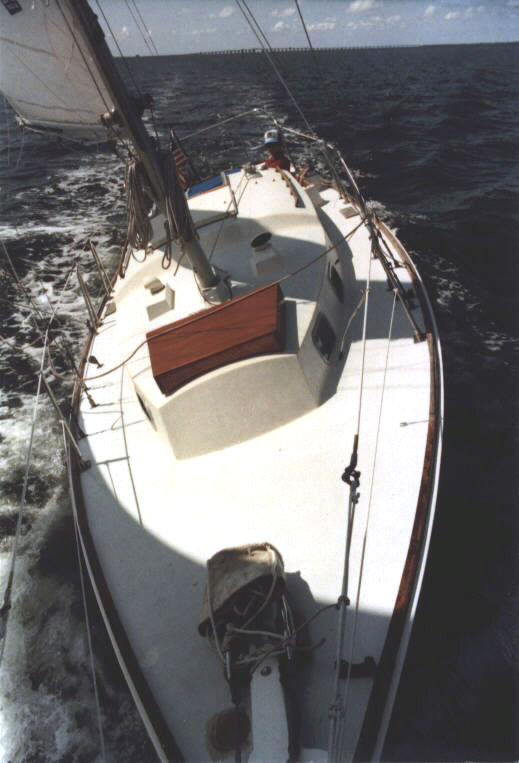
|
Home News Plans Dimensions Projects Modifications Sources Links About Site Map Search |
|
|
|
|
|
About Sally B #165 |
|
|
This site details all the work I have done to my '71 Bristol 29 and all the work I will do from this point forward. The boat and I started out with old blown out sails, funky roller reefing that never worked, useless aluminum Southcoast winches, and an antique Volvo MD2B rated at 12 hp but throwing only a 12-inch diameter prop so that its effective usefulness was about 4 hp at the shaft. The boat had sat on a mooring during the sailing seasons in New England, and the old bronze sea cocks were mostly seized. The engine sported this Rube Goldberg water-jacketed copper exhaust muffler that must have weighed 150 pounds. It had a leaking water tank, too small of a fuel tank and a head that didn't work. I noted all this and just saw her beautiful lines and all that potential.
I added
a bowsprit in '88. Re-powered her with a Yanmar 3GM30F in "90, adding
more batteries, refrigeration, rewiring the engine compartment and replaced
the sails and some canvas. In '94 I added 4 group 27 West gel cell batteries and a
separate starting battery. In '95, I rewired the entire boat, added radar,
GPS, A Signet wind machine, Ampair wind generator, repainted the boat in
Awlgrip, replaced all the seacocks with Marelon fittings, and rebuilt the
rudder. See the Plans page for what I intend
to do for this refit. |
 |
|
About Bristol 29's |
|
|
Are you thinking about buying a B29 or other vintage Bristol from the 1960's? Here are some things to consider, some strengths of Bristol yachts and some areas of weakness that you should watch for. Strengths
Weaknesses:
|
|
|
About me |
|
|
I have sailed, and worked on and with boats--about 50 years now--since I was a kid, learning both skills from my father. Four years in the Navy only whet my appetite for the engineering side of boating. I would rather sail than eat and I usually like to head out when everyone else is being chased in by approaching bad weather. I have sailed too many small boats to count including racing Lightnings, Flying Dutchmen, Blue Jays, Inland Scows, and Snipes, and sailing my Bristol for the past 21 years in most of the waters in and around Florida to deep out into the Gulf, the Dry Tortugas and the Keys. I have done almost all the work on the Bristol's refits myself, other than stainless steel welding and sail making, and what I don't yet know I will surely learn as a part of this refit. Hopefully there will be generous souls out there who will contribute to this site and teach me some of what I don't know...the rest I will pick up along the way.
|
 |
| How to reach me: email me at davebro31 at g mail dot com | |
|
Copyright © 2005 - 2009 by David Browne, all rights reserved, hosted in USA
|